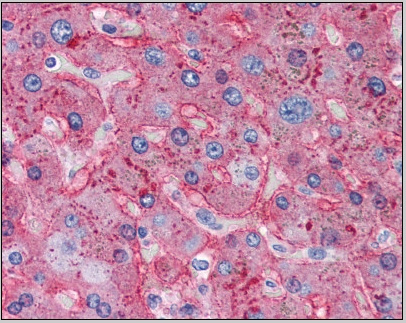Apolipoprotein B (APOB) Goat Polyclonal Antibody
CAT#: R1032P
Apolipoprotein B (APOB) goat polyclonal antibody, Purified
Need it in bulk or conjugated?
Get a free quote
CNY 21,694.00
货期*
4周
规格
| Cited in 2 publications. |
Specifications
| Product Data | |
| Applications | ELISA, IHC, IP, WB |
| Recommend Dilution | Anti-apoLipoprotein antibodies have been used for indirect trapping ELISA for quantitation of antigen in serum using a standard curve, for Immunoprecipitation and for Western blotting for highly sensitive analysis. Recommended Dilutions: ELISA: 1/2,000-1/10,000. Western blot: 1/200-1/1,000. Immunoprecipitation: 1/100. Immunohistochemistry: 1/50-1/500. |
| Reactivity | Human |
| Host | Goat |
| Clonality | Polyclonal |
| Immunogen | apoLipoprotein Type B isolated from Human plasma by density gradient centrifugation followed by HPLC purification. |
| Specificity | This product has been prepared by immunoaffinity chromatography using immobilized antigens followed by extensive cross-adsorption against other ApoLipoproteins and human serum proteins to remove any unwanted specificities. Typically less than 1% cross reactivity against other types of apoLipoprotein was detected by ELISA against purified standards. This antibody reacts with Human ApoLipoprotein B and has negligible cross-reactivity with Type A-I, A-II, C-I, C-II, C-III, E and J ApoLipoproteins. Non-specific cross reaction of anti-apoLipoprotein antibodies with other Human serum proteins is negligible. |
| Formulation | 0.125M Sodium Borate, 0.075M Sodium Chloride, 0.005M EDTA, pH 8.0, with 0.01% (w/v) Sodium Azide as preservative. State: Purified State: Liquid (sterile filtered) purified Ig fraction. |
| Concentration | lot specific |
| Purification | Immunoaffinity Chromatography. |
| Conjugation | Unconjugated |
| Storage Condition | Store the antibody at 2-8°C prior to opening. Dilute only prior to use. For extended storage mix with an equal volume of glycerol, aliquot contents and freeze at -20°C or below. Avoid cycles of freezing and thawing. |
| Gene Name | apolipoprotein B |
| Database Link | |
| Background | Lipids (triglyceride (TG), cholesterol (Chol), phospholipids (PL), cholesteryl esters (CE)) are insoluble in plasma. These lipids combine with apolipoproteins to form lipoproteins. This process solubilizes lipids in plasma. Lipoproteins provide a transport system for lipids. They also play an important role in lipoprotein receptor recognition and regulation of certain enzymes in lipoprotein metabolism. Apolipoprotein B plays an essential role in lipid transport and metabolism. Apo B may regulate cholesterol synthesis through its interaction with specific cell membrane receptors and by inhibition of HMG Co A reductase. This enzyme has been identified as the rate controlling enzyme in cholesterol biosynthesis. Apo B may be important in the genesis of atherosclerosis. Apo B is the major protein moiety of all lipoproteins other than high density lipoprotein (HDL) in plasma. Increased levels of apo B100 are associated with an increased risk of coronary artery disease. Apo B exists in human plasma as two isoforms: apo B48 and apo B100. Apo B100 is the major physiological ligand for the LDL receptor. It contains 4536 amino acid residues (Chen et al., 1986; Law et al., 1986). Apo B100 is the full length protein. Its gene has been mapped on the short arm of chromosome 2, with an approximate length of 43 kilobases and 29 exons (Ludwig, et al., 1987). The LDL-binding domain of the molecule is proposed to be located between the aa3129-3532 (Knott, et al., 1986). Apo B100 is synthesised in the liver. It is required for the assembly of very low density lipoproteins (VLDL). |
| Synonyms | ApoB, Apo-B, ApoB100, ApoB-100 |
| Reference Data | |
Citations (2)
| The use of this Antibodies has been cited in the following citations: |
|---|
|
Circulating oxidized LDL, increased in patients with acute myocardial infarction, is accompanied by heavily modified HDL
,Sawada, N;Obama, T;Koba, S;Takaki, T;Iwamoto, S;Aiuchi, T;Kato, R;Kikuchi, M;Hamazaki, Y;Itabe, H;,
Journal of lipid research
,PubMed ID 32291330
[APOB]
|
|
Impact of Glutathione Peroxidase-1 Deficiency on Macrophage Foam Cell Formation and Proliferation: Implications for Atherogenesis
,null,
PLoS ONE
,PubMed ID 23991041
[APOB]
|
Documents
| Product Manuals |
| FAQs |
| SDS |
Resources
| 抗体相关资料 |
Customer
Reviews
Loading...


 United States
United States
 Germany
Germany
 Japan
Japan
 United Kingdom
United Kingdom
 China
China

